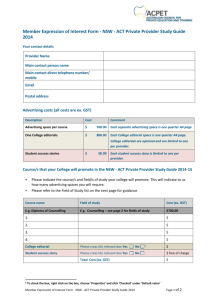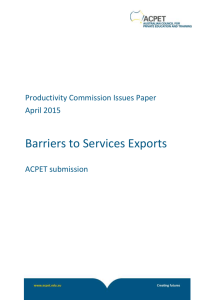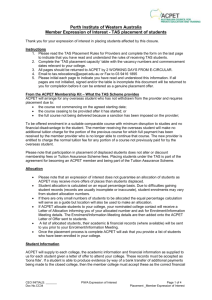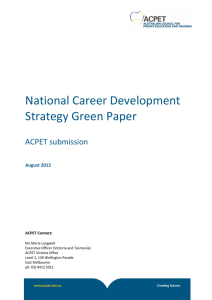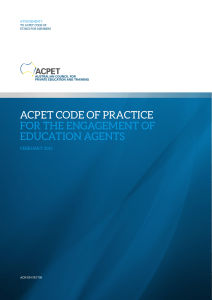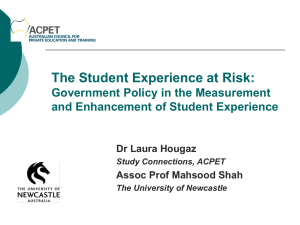ACPET Journal for Private Higher Education
advertisement
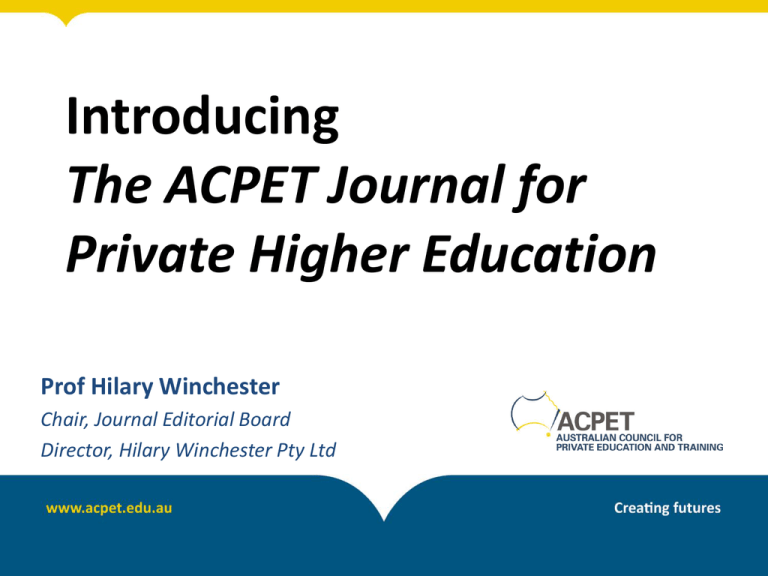
Introducing The ACPET Journal for Private Higher Education Prof Hilary Winchester Chair, Journal Editorial Board Director, Hilary Winchester Pty Ltd The ACPET Journal for Private Higher Education • A new, biannual publication for scholarly activities on the theory and practice of higher education in the context of the private sector. • Provides a new opportunity to develop and enhance the scholarly understanding of the private higher education sector, and is a key outlet for the sharing of good practice. The ACPET Journal for Private Higher Education Articles on the following topics related to the private education sector are considered: – higher education policy and practice – teaching, learning and curriculum design – quality assurance – postgraduate education – academic leadership and management – academic work. Article formats include traditional academic research articles, comparative reviews, case studies as well as empirically-based papers. Inter-disciplinary and comparative international perspectives are welcome. The ACPET Journal for Private Higher Education • The inaugural issue of the ACPET online journal was launched on 27 June 2012. It is freely available to be read and downloaded from the ACPET website at http://www.acpet.edu.au/ • The journal received widespread recognition and very positive feedback. The journal website received over 4000 hits over 3 months. The ACPET Journal for Private Higher Education The journal aims to: • be relevant to the private higher education sector • provide rigorous, up-to-date research – raising expectations – ‘double-blind’ peer-reviewed by an editorial team of scholars – ratified by Editorial Board • reach educators, scholars, students, practitioners, policymakers and consultants in Australia and around the world. Contributing factors to the founding of journal • • • • • • The journal meets an unfulfilled need. According to Ryan (ACPET Journal, issue 1, 2012), private higher education has grown so rapidly that it now represents 50 per cent of providers and 10 per cent of students. Research about, and by the private education sector in Australia and around the world has largely been ignored. There is increasing interest in the field of private higher education by researchers. The journal reflects ACPET’s visionary thinking, its significant support, and its strategic positioning in a growing industry. Introduction of a new regulatory framework for the private higher education sector. Development of new technology and media enables wide and faster circulation of online journal. A superb editorial team (Editorial Board, Editor, and Reviewers) that works hard and is committed to ensure high quality of articles. A new regulatory framework • From the 30 January 2012 the Tertiary Education Quality and Standards Agency (TEQSA) assumed the regulatory functions of all higher education providers. TEQSA has developed a new regulatory framework and new standards. According to TEQSA PROVIDER CATEGORY STANDARDS, a higher education provider must now meet the following criterion to be registered/re-registered as a “Higher Education Provider”: The higher education provider’s academic staff are active in scholarship that inform their teaching, and are active in research when engaged in research student supervision. The ACPET Journal for Private Higher Education The journal’s inaugural edition showcases – the institutional diversity – the breadth of interest and expertise in private higher education – the quality of scholarship of researchers in Australia and beyond who are interested in the myriad of issues relevant to private higher education. Process for publication • Papers are submitted for publication by due date. • Papers are double-blind refereed (unnamed, by two reviewers). • Papers may: – be accepted in present form (no changes required) – require ‘minor revisions’ – require ‘major revisions’ – be declined. Journal Issue 1, 2012 - Submissions 12 papers were submitted for issue 1 of the journal. Outcome of review process: • two papers declined (content not relevant to private education sector) • five papers accepted for publication after minor revisions completed • five papers required to resubmit after ‘major revisions’ completed. Resubmitted papers will be considered for publication in following issue(s). Journal Issue 1, 2012 – Articles published • • • • • Growth and consolidation of the Australian Private Higher Education Sector (Peter Ryan, Peter Ryan & Ass) Was it worth it? The effectiveness of external quality audit in a private higher education institution (Mahsood Shah, RMIT University) Developing a strategic capability for student engagement using social capital: A case study at a pathways college (Kathleen Mendan, Swinburne College) The Australian School of Management’s business degree curriculum: An innovation in collaborative symbiosis (Alfred Ogle, Eunice Liu & Alan Williams, Australian School of Management; Steffern Zorn, Curtin University) Curriculum review at a New Zealand private college: Dissecting the knowledge typology, curriculum logic, and cognitive complexity (Robyn Carruthers & Patsy Paxton, South Pacific College of Natural Therapies, NZ). Evolution of journal in future Editorial Board is considering a range of issues: • advertisement in journal • ways of further disseminating journal • inclusion of articles written by specialists, advisors on topics of wide/particular interest • inclusion of reviews of books/articles. • A broad range of topics and approaches can be developed, including comparative studies, policy changes and their implications, and issues of governance and management. Invitation to contribute We invite you to contribute an article on the issues and debates that are of particular interest to you, and/or have been raised at this conference. Deadline for issue 2 is Monday 10 September 2012. Submissions are also accepted on a continuous basis. Issue 2 will be published in early December 2012. For further information contact the Journal Editor, Dr Laura Hougaz (refer to flyer in conference satchel) The quality stamp CHANGE IMPLEMENTATION IN AN EDUCATIONAL CONTEXT © Suzie Haddock Director of Education JMC Academy CHANGE IMPLEMENTATION • Change as an internal challenge • Senior managers know what has to be done • Middle managers and other employees may rebel against the change • Depending on the level of change staff will work out whether they want to remain employed in an institution which has changed THE HARD WORK OF BEING A SOFT MANAGER WH Peace HBR, 2001 Internal communications are said to be integral to employee’s clarity of purpose and employee advocacy in shaping the organisation’s external reputation. They are also a critical success factor for change or transformation programs. (Nicholson, 2010) EXTERNAL POLITICAL AND LEGISLATIVE REQUIREMENTS GOAL: Ensure that staff understand the reasons for the change itself ACTIONS: Create a plan to communicate the change Decide which tools to use and for what Recognise those who follow the plan; gently nudge those who don’t Model, reinforce and constantly refer to the plan THE INNOVATION PROCESS (Beckman and Barry 2007) THE INNOVATION PROCESS 3. Tell me what’s missing 2. Show me something new 1. Make me care 4. Show me opportunities 5. Make it tangible (Beckman and Barry 2007) KOUZES AND POSNER - 1987 The Five Practices and Ten Commitments Model the Way (or make me care) 1. Find your voice by clarifying your personal values 2. Set the example by aligning actions with shared values THE FIVE PRACTICES AND TEN COMMITMENTS Inspire a Shared Vision (show me something new) 3. Envision the future by imagining exciting and ennobling possibilities 4. Enlist others in a common vision by appealing to shared aspirations THE FIVE PRACTICES AND TEN COMMITMENTS Challenge the Process (tell me what’s missing) 5. Search for opportunities by seeking innovative ways to change, grow, and improve 6. Experiment and take risks by constantly generating small wins and learning from mistakes THE FIVE PRACTICES AND TEN COMMITMENTS Enable Others to Act (show me opportunities) 7. Foster collaboration by promoting cooperative goals and building trust 8. Strengthen others by sharing power and discretion THE FIVE PRACTICES AND TEN COMMITMENTS Encourage the Heart (Make it tangible) 9. Recognize contributions by showing appreciation for individual excellence 10. Celebrate the values and victories by creating a spirit of community MOTIVATION TO CHANGE A large international study published in 2009 found that when it comes to management skills, Australian companies are not great performers. And that has a direct impact on our productivity. The main problem? Talent and ideas are not always recognised by managers. COMPANIES ARE ONLY GOING TO SURVIVE IF THEY ARE AGILE Most importance is the cross boundary thinking that allows a person to acquire (and to do) much better problem solving in their area. We need innovation and a way of doing things better. We haven’t translated innovation into the market place – we have ideas but they tend to be stifled rather than encouraged. Management is absolutely key to our prosperity in the future: the growth of productivity, and the contribution to sustainability and social inclusion. Professor Roy Green Dean of the Faculty of Business at the University of Technology, Sydney THE INNOVATION CIRCLE FOUR CRITICAL CHALLENGES IABC, 2010 • Motivate employees to align with the business strategy • Leadership and management communication • Managing information overload • Measure the return on investment MOTIVATE EMPLOYEES TO ALIGN WITH THE BUSINESS STRATEGY • We made staff understand that the change was going to improve how they felt about the business; • Empower middle managers to make more decisions but to be held accountable for those decisions; LEADERSHIP AND MANAGEMENT COMMUNICATION • Track the amount of communication that is sent out – emails, workshops, phone calls, meetings, messages from colleagues – they all add to the load; • Timing is very important – too soon and its forgotten, too late and there is not enough time to digest the information and act on it; • Set up a communication plan – try and stick to it! MANAGE INFORMATION OVERLOAD • Set up a communication plan – try and stick to it; • Plan what you will do (and when) if staff don’t get back to you by the deadline. MEASURE THE RETURN ON INVESTMENT • Sense of pride in the organisation; • Feeling of having contributed to the change; • Understanding of need for change; • More able to deal with it next time. INTERNAL OR ORGANISATIONAL COMMUNICATION The goal of organisational communication: • is free flowing transfer of information (Carlopio, 2008), • empowerment of staff to enact tasks efficiently (Hubbard, 2008) • adapt to organisational change effectively (Beatty, 2003; Sinickas, 2010) • effective business mergers (Harland Clarke – C Barton, 2009), and • a higher level of engagement by all stakeholders in organisational goals (McCarthy, 2006) WHAT WOULD I DO DIFFERENTLY? • Keep up with the newsletter (make a plan) • Be more aware of information overload (make a plan) • Become better at saying thank you to staff THE HARD WORK OF BEING A SOFT MANAGER There is good news and there is bad news Don’t wait to give either
